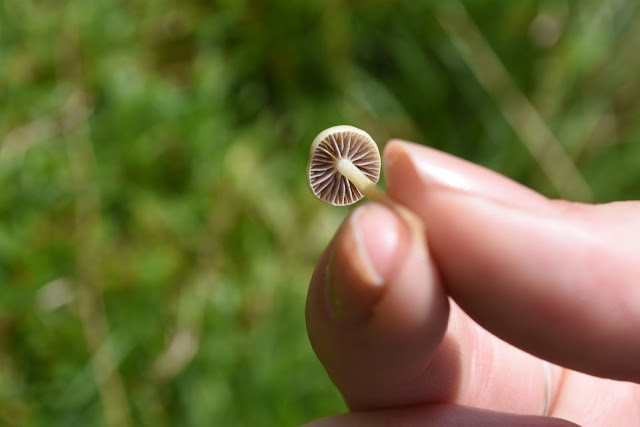The start of mushroom season is finally upon us, and I couldn't be more excited. Although the bouts of rain weren't ideal for our wedding last week, they did mean lots of exciting finds during our honeymoon, walking through damp North Wales.
I will no doubt make many posts about the intriguing finds we stumbled across during our time away, but I wanted to start at our first fungal encounter, the Dung Roundhead, or Stropharia semiglobata.
Scattered across the huge pastures we were walking through were hundreds of them. And though the name suggests they grow exclusively on dung, the majority of them were in fact beside dung.
The gills are adnate and ranged in colour depending on the age of the mushroom. Younger ones had a more purplish tinge to them, while the more mature species had black gills.
The spore print is a dark purplish-brown colour.
Characteristics
Habitat: On or beside dung, usually in pasture.
Cap: 1-3cm across, hemispherical. Cream to yellow in colour.
Stem: Yellowish in colour, turning paler towards the cap. Incomplete ring or ring zone is sometimes present.
Gills: Adnate. Purplish-brown, becoming black with age.
Spore print: Dark purplish-brown
Season: Spring to late autumn
Edibility: Inedible
This mushroom can be confused with the Magic Mushroom. The best way to tell the difference between the two is to note the shape of the cap - Roundheads have a distinctly round shape, whereas Magic Mushrooms have a point in their cap.
All pictures have been taken by my wonderful husband, Matthew Leatherbarrow.
Disclaimer: I am not an expert. Never eat a mushroom you've found without confirmation that it is edible by an expert.
I will no doubt make many posts about the intriguing finds we stumbled across during our time away, but I wanted to start at our first fungal encounter, the Dung Roundhead, or Stropharia semiglobata.
Scattered across the huge pastures we were walking through were hundreds of them. And though the name suggests they grow exclusively on dung, the majority of them were in fact beside dung.
The gills are adnate and ranged in colour depending on the age of the mushroom. Younger ones had a more purplish tinge to them, while the more mature species had black gills.
The spore print is a dark purplish-brown colour.
Characteristics
Habitat: On or beside dung, usually in pasture.
Cap: 1-3cm across, hemispherical. Cream to yellow in colour.
Stem: Yellowish in colour, turning paler towards the cap. Incomplete ring or ring zone is sometimes present.
Gills: Adnate. Purplish-brown, becoming black with age.
Spore print: Dark purplish-brown
Season: Spring to late autumn
Edibility: Inedible
This mushroom can be confused with the Magic Mushroom. The best way to tell the difference between the two is to note the shape of the cap - Roundheads have a distinctly round shape, whereas Magic Mushrooms have a point in their cap.
All pictures have been taken by my wonderful husband, Matthew Leatherbarrow.
Disclaimer: I am not an expert. Never eat a mushroom you've found without confirmation that it is edible by an expert.




Thanks for sharing this quality information with us. I really enjoyed reading. Will surely going to share this URL with my friends. Shrooms online
ReplyDeleteThis comment has been removed by the author.
ReplyDeleteThis is a smart blog. I mean it. You have so much knowledge about this issue, and so much passion. You also know how to make people rally behind it, obviously from the responses. Unicorn grow bags
ReplyDeleteThis is a brilliant blog! I'm very happy with the comments!.. golden teachers
ReplyDelete